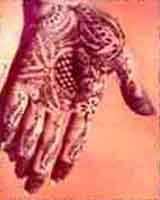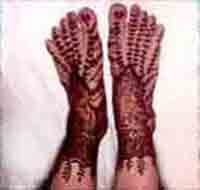|
|
|
Mehndi
|
|
| What
is Mehndi? |
|
Mehndi
is an ancient art form in which henna is used to create intricate
designs on parts of the human body. Derived from the leaves
of the evergreen plant Lawsonia Inermis, henna contains
a natural chemical that interacts with the keratin of the
skin and hair to give it an rust-red coloration. With its
beautiful delicate patterns, mehndi is worn for religious
and cultural celebrations by women in India, the Middle East,
and Africa. Traditionally mehndi is applied to the hands,
wrists, arms, feet, and ankles, but it can also be applied
to other parts of the body. In India extremely fine lacy,
geometric, or floral designs covering entire hands, forearms,
feet, and shins are prevalent.
|
 Facinated
Art
Facinated
Art |
|
History of Mehndi: |
|
The
art of mehndi dates as far back as 3000 BC. The ancient Egyptians
applied henna to their nails and feet. From Egypt and other
African countries the art of mehndi spread to the Middle East.
It was probably taken to India either by the Persians when
Mahmud of Ghazni invaded India during 1001-26 AD, or by the
forerunners of the mugal empire around 1500 AD. The one thing
that can be said with certainty is that mehndi became an integral
part of the cultural traditions of many countries in this
part of the world.
|
|
The Art of Applying Mehndi: |

Intricate Embossing on Delicate Hands
|
The basic ingredient in mehndi are the
leaves of the henna plant Lawsonia Inermis. The dry
leaves are crushed into a soft powder and mixed with water,
lime juice, and tea to form a smooth paste. Usually the paste
is prepared the night before it is to be applied. Before the
application of mehndi the skin is washed thoroughly with soap
and water and conditioned with either eucalyptus oil or a
special mehndi oil. Then the henna paste is applied either
freehand, or with some aids like a toothpick, stencil, or
an improvised cone similar to that used for icing cakes.
|
|
After the design has been applied, the
paste is allowed to remain on the skin. Care is taken to not
let it dry too much as it tends to flake off. A mixture of
two parts lemon juice and one part sugar is applied at regular
intervals to prevent this from happening. It is recommended
that the paste be left on for at least four hours, although
the longer it stays on the darker and more intense the color
will be.
|
 Delicate
Touchings
Delicate
Touchings |
| Once
the henna paste has been removed, the final design may last
any where from two to six weeks, depending upon the quality
of henna used and how often the hands and feet come in contact
with soap and water. |
|
The Indian Tradition: |
|
Mehndi
is deeply ingrained in the Indian tradition. Although applied
on other occasions as well, it is an integral part of the
wedding ceremonies and is almost synonymous with the marriage
of a woman. A special time is set aside for the application
of mehndi to the hands and feet of the bride-to-be. Usually
the ceremony takes place on the night before the actual wedding.
The bride will be surrounded by all the female members of
the household, as well as the friends, she has grown up with,
and close relatives who have come to attend the wedding. There
will be much singing and dancing interspersed with bouts of
teasing the bride. It is an atmosphere full of joviality,
nostalgia, and a tinge of sadness. The ceremony will probably
last into the week hours of the morning when, finally, the
women will retire for a few hours slumber only to wake up
for a hectic day ahead for the wedding. The bride will usually
sleep with the mehndi paste still on her hands and feet and
not wash it off until the next morning. This is crucial, since
the longer the paste stays on, the darker is the ultimate
color. The next morning, when she does wash her hands and
feet, everybody will come to admire the intricate patterns
and the deep vibrant color. The darker the color the more
her mother-in-law and husband are supposed to love her. Traditionally,
as long as the bride has mehndi on her hands, she will not
be asked to do any household work or chores at her mother-in-laws
house once she reaches there after the wedding. So, the bride
has her own special interests in trying to keep the mehndi
paste on as long as possible to get the darkest possible color!
|
|
|